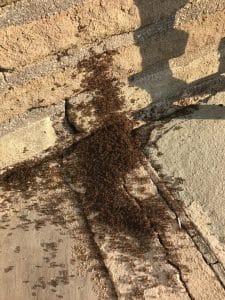Table of Contents
Ants Infestation in the House:
How to Know When Ants Take Up Your Home or Business
No one wants am ants infestation in the home or commercial building. Even the smallest ants have a somewhat painful bite, one that can be especially painful for smaller children and pets.

Ants Infestation (Photo Credit: Rest Easy Pest Control)
Ants are one of the most diligent species in the entire animal kingdom. Their foraging abilities are unmatched, as are their communication skills within a colony. Most ants that we deal with in our homes are not dangerous. They don’t carry disease. They don’t suck our blood at night. And, with the exception of carpenter ants, they don’t damage our homes. That being said, we don’t want them around, even if they’re not the wood-chewing type.
When your problem just won’t go away, its time to call your local ant exterminator. In Long Island and New York City, that’s Rest Easy Pest Control.
Signs of an Ants Infestation
Here are three signs how you can catch an ant infestation at home early before it turns into something we can’t handle:
Sign #1: Wood shavings on the floor.
This indication of ant infestation in the home refers specifically to carpenter ants, which often leave wood shavings on the floor wherever they’re digging. For the record, these ants don’t actually eat or ingest your wood as termites do. Instead, they simply chew through the wood and discard it as they burrow into the wood.
These critters don’t usually cause nearly as much damage to your home as termites, but the damage can be sufficient if they’re not exterminated in a timely manner.
Sign #2: Visual identification of ants.
It’s happened to all of us. We walk into a kitchen, a basement, an attic, or even somewhere outside, and find a line of worker ants in search of food. But don’t look at this as a bad thing. If you’re just noticing the line of ants, chances are this ant infestation at home isn’t too bad. Which means now might be the best time to strike.
You can use an over-the-counter pesticide or follow the workers to their colony and plug it up using a specialized poison that will fill the entire ant hill. If you find a line of ants somewhere, perform a thorough inspection of your house — interior and exterior — and see if you can find others. Also, check your yard for signs of an ant hill.
One great thing about ants is that they don’t try to hide. Unlike insects such as cockroaches and crickets, they have no need to find shelter. Their only thought is to search for food, find it, and bring it back to the colony.
That’s why you’ll often see an ant struggling with a big piece of food or debris, trying desperately to return it to the ant’s home, but you’ll never see him give up, even if you try to disturb him. Because of this, it’s quite easy to determine whether you’re dealing with a few ants or a small ant infestation. All you need to do is look around and you’ll figure it out.
Sign #3: Sighting of winged ants.
While this could be part of the visual identification, we’re putting this into its own category because it is very specific. Many people are under the impression that either a) there may be species of ants where all of them have wings or b) what looks like a winged ant is actually another type of insect because, after all, ants don’t fly…do they?
The answer to this is twofold. First of all, there is no such thing as a species of ant, anywhere in the world, that consists of only winged individuals. And second, a winged ant is simply a reproductive ant. Only a handful in a colony will have wings. Of course, if you think it might be a termite, a quick online visual comparison will answer that concern.
If you spot a winged ant, it doesn’t necessarily mean that you’re seeing the first sign of an ant infestation at home, but since this is a possibility, now is the time to be more resilient. This early sign could help prevent a bigger problem later on.

Carpenter Ants. These ants don’t actually eat or ingest your wood as termites do. Instead, they simply chew through the wood and discard it as they burrow into the wood.
How Quickly Can Ant Infestations Spread
Ant infestations in the home aren’t something to be taken lightly. If they’re not tackled in a relatively short amount of time, you might find yourself with a much larger problem. This is because after a small number of ants have discovered food, they signal others from their colony.
Once this signal has been sent to the rest of the colony, it’s only a matter of time before many of the little critters have shown up on your doorstep.
The speed at which ant infestations in the home spread relies on a few factors. First and foremost, it depends on how dispersed the colony is. An entire ant colony simply can’t concentrate on one area. The stakes are too high. Instead, they’ll lay claim to a number of areas around your home, both inside and out.
The speed at which it spreads is also dependent on the amount of food that they can find. If you’ve left food lying out in numerous areas, the ants will likely spread faster to cover more ground.
Getting Rid of a Small Ant Infestation: Use Spray and Ant Bait Trap
If you discover quite a few ants in your home, a small ant infestation may already be underway. Your best plan of action, in this case, is to eliminate them as soon as possible, before the problem becomes much bigger. Some homeowners will reach for the spray of insecticide, but depending on their numbers, that might not be enough to fix the problem.
Another method that you might want to do is pick up some ant traps at your local pest control supplier. These traps will attract the ants to a piece of poison inside the unit, which they’ll take back to the colony. The poison is slow-acting, and once inside, it will begin eliminating the colony from within.
Ant Problem: Use Professionals to Exterminate Ants

Ant Nest (Photo Credit: Rest Easy Pest Control)
Although any insecticide on the market can kill the little critters, there are certain products that are specifically made for ants. Plus, there are a number of powders available for use, as well. However, as effective as these might be, you need to consider the danger of using these products if you have pets or small children in the house.
A safer alternative — and consequently, more effective — would be the use of a baiting system. These devices are easy to use and can help stop ant infestations in the home from spreading.
They work by enticing the ant to carry a piece of poison back to the colony. Once it has reached the colony, this poison will attack the other ants, which takes care of the problem at the source.
We understand that most people will attempt to handle this problem on their own. This is completely understandable. However, if the problem continues to reoccur year after year, clearly this is a problem that should be resolved by a professional Long Island, NY exterminator.
Our ant exterminators have all of the skills necessary to effectively treat your ant problem and any other pest infestations that you might have. Do not hesitate to contact us so that we can eliminate your pest infestation problem for you.***

Related Articles:
- What Do the Dangerous Fire Ants Eat?
- Carpenter Ants Infestation
- Natural Ant Deterrents
- Ant Brain vs Human Brain
- Ants in the House: Why They Love Your Kitchen
- Flying Ants vs. Winged Termites
- Ant Problem in Spring
- Types of Ants: Indoor vs. Outdoor Ants
- Army Ants Infestation in the Home
- Ants Infestation in the House
